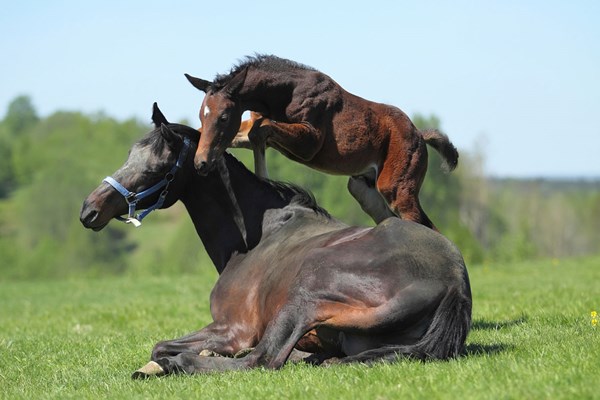 Credit: Thinkstock
Credit: ThinkstockOne of the mainstays of horse health management is to address the problem of internal parasite infection in all ages of horses. For the common internal parasites, the mode of transmission relies on ingestion of actively infective larvae from the environment. Once in the horse’s intestinal system, they mature through several life stages to become adult worms; the females then lay eggs and the eggs are passed in the feces into the environment where, in favorable climatic conditions, they develop into infective larvae ready to be consumed by a horse.
Small Strongyles (Cyasthostomins)
First and foremost among the primary concerns to equine intestinal health are the small strongyles. Known for their tendency to burrow into the lining of the intestine and remain dormant in this encysted form for a period of time, they are important because of the inflammatory conditions they create upon emergence from the intestinal lining. If large numbers of these larvae emerge simultaneously, an infected horse can experience any variety of intestinal upsets, including colic and diarrhea.
While in an encysted state, small strongyles are “protected” against many available deworming medications. To date, only moxidectin (Quest) or a 5-day course of fenbendazole (Panacur PowerPak) have been shown to have larvicidal action (the ability to attack the encysted stage of the parasite). There are indications that worm resistance is developing to these previously effective dewormers. Fecal egg counts help determine how often it is necessary to deworm based on numbers of eggs seen through microscopic examination of a manure sample and which horses are the primary shedders in your herd.
Large Strongyles (Bloodworms)
Historically, large strongyles posed one of the greatest threats to horse health and caused death in many. The advent of new deworming products in the 1980s led to aggressive deworming strategies–every two months–that have significantly reduced this threat.
Bloodworms live inside blood vessels that feed the intestinal tract; there they can cause damage and emboli (blood clots) that compromise blood circulation to the bowel. Affected horses appear unthrifty, suffer weight loss, and can develop colic or anemia. Most commercial dewormers are able to kill this parasite, so it no longer poses the health threat that made it infamous in the past.
Ascarids (Roundworms, Parascaris equorum)
Roundworms are primarily a disease of young horses (yearlings or younger) that have not yet developed effective immunity against them. The adult worms grow so large (pencil thick and five inches long) that a tangle of them in the small intestines can cause complete blockage and/or intestinal rupture. Their life cycle also involves migration through the lungs and liver, where they can set up inflammatory conditions to elicit cough and respiratory problems. A young horse with a large ascarid burden may display a rough hair coat, an unthrifty, pot-bellied appearance, weight loss, coughing and have colic episodes.
Caution must be taken when deworming an infected horse as rapid die-off from the dewormer can cause serious impaction colic. To minimize infection risk, a pregnant mare should be dewormed against ascarids within 30 days prior to her foaling due date. Foals should not be dewormed against ascarids before 60-70 days of age in order to minimize development of dewormer resistance, which is currently occurring with the avermectins (moxidectin and ivermectin).
It takes 10-12 weeks from the time of ingestion of the parasite larvae for the worm to develop into an adult, egg-laying form. Ascarid eggs are incredibly tenacious in the environment, lasting for as long as 5-10 years even in extreme weather conditions.
Tapeworms (Anoplocephala perfoliata)
Tapeworms in horses are transmitted through an intermediary host, an orbatid “forage” mite that is consumed in pasture, hay or grain. The tapeworm develops into an infective larva within the mite, which when ingested by the horse, develops into an adult tapeworm–the female sheds eggs within 6-10 weeks. The tapeworms collect at the ileocecal junction located between the small and large intestines. There they may elicit sufficient inflammation and bowel disturbance to cause impaction or spasmodic colic, and in some cases may cause a segment of the small intestine to slide into the opening of the cecum (intussusception), which is a seriously painful surgical condition.
Very young horses and those over age 15 seem to be most at risk of tapeworm infection probably due to reduced immunity with youth or age. Control is managed using praziquantel given once or twice a year.


